

The COURIER
900 Nativity SetS
Austin Knights of Columbus Are gifted "nAtivity house" ColleCtion
By NICK RELLER
�his Advent and Christmas season, Queen of Angels Parish in Austin becomes the new home for a display of nativity sets that some area residents may recognize as having belonged to the Nativity House of Austin.
From 2003 until last year, retired teachers Helen and Bill Holder welcomed the public into their home each year to view their more-than 900 nativity sets, which they began collecting in 1968. It is believed to be the largest collection in Minnesota, and among the largest in the United States and Canada.
After the Holders announced that last Christmas would be the Nativity House's final season, Neil Drees of the Austin Knights of Columbus made a visit with his wife, was amazed by the collection, and learned from the Holders that there was no plan in place for the future of the nativity sets.
Through collaboration among the Holders, the Knights of Columbus, former Queen of Angels Pastor Fr. Raúl Silva, and current Pastor Fr. Jim Starasinich, a plan formed to turn some classrooms of the former parish school into a Nativity House museum that will remain open by appointment year-round, in addition to its walk-in Christmas schedule (Nov. 30 - Jan. 11) of 12-5 p.m. Saturdays and 10 a.m. to 5 p.m. Sundays.

A Worldwide Tradition
Since 1223, when St. Francis of Assisi created the first seasonal nativity scene, with living people and animals in a cave outside of Greccio, Italy, the tradition of nativity scenes has invited Christians around the world to reflect on the incarnation of Christ with images that resonate within their own homes and cultures.
The worldwide reach of the tradition is on full display in the Nativity House collection, which, at the time of this writing, is still being unpacked by Knights and parish volunteers, from 98 totes and boxes (not
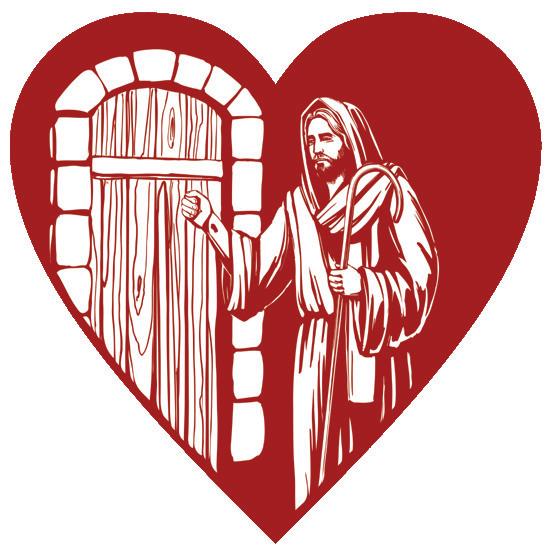
USCCB November Plenary Assembly
By LEANDRA HUBKA
�hat do you get when 250+ Catholic bishops from the entire United States, gather in one location? Welcome to the November Plenary Assembly of the United States Conference of Catholic Bishops (USCCB), held annually in Baltimore, Maryland, home of America’s first diocese and cathedral.
This year, I was privileged to have been afforded an inside glimpse into this episcopal gathering. In addition to the bishops and requisite USCCB staff, attendees at the “General” (open) Sessions also include select guests, approved media, and invited observers. Observers represent an array of Catholic associations and groups; as a consecrated virgin active in the US Association of Consecrated Virgins, I was asked to represent US consecrated virgins at this year’s November Assembly.
Central to the bishops’ time together is both prayer and fraternity. Daily Masses concelebrated by hundreds of bishops are held in a large wing of the convention center configured as a chapel. One room is set aside as the Adoration Chapel, where Jesus is reserved (or exposed) in the Blessed Sacrament and attendees can stop by for private prayer. Meals are a time of sharing and fraternity, which observers were welcome to join on the days of the General Sessions.
The General Sessions are the public portion of the Assembly, held on Tuesday and Wednesday of the Monday-Thursday gathering. These include addresses by the apostolic nuncio and USCCB


Pope Tells U.S. High School Students Their Voice, Ideas, Faith Matter
By CINDY WOODEN, Catholic News Service
VATICAN CITY, Nov. 21, 2025 (CNS)Pope Leo XIV urged U.S. high school students to be "intentional" with their screen time, their prayer time and their involvement in a local parish.
"One of my own personal heroes, one of my favorite saints, is St. Augustine of Hippo," the pope told 16,000 young Catholics meeting in Indianapolis. "He searched everywhere for happiness, but nothing satisfied him until he opened his heart to God. That is why he wrote, 'You have made us for yourself, O Lord, and our heart is restless until it rests in you."
With a livestream connection, Pope Leo spoke for close to an hour Nov. 21 with participants at the National Catholic Youth Conference meeting at Lucas Oil Stadium in Indianapolis.
The pope responded to questions from five high school students: Mia Smothers from the Archdiocese of Baltimore; Ezequiel Ponce from the Archdiocese of Los Angeles; Christopher Pantelakis from Nevada; Micah Alciso from the Diocese of Honolulu; and Elise Wing from the Archdiocese of Dubuque, Iowa.
The questions were developed in meetings with other students and adults and were sent to the pope in advance.
Pope Leo did respond to a question and comment posed by Katie Prejean McGrady, who was moderating the event. She mentioned that she had given the pope a pair of socks some time ago and said she wanted to know what he used as an opening word when he played Wordle each day.
"I just want to say I only wear white socks, and I use a different word for Wordle every day, so there's no set starting word," the pope said, before turning to the young people's questions.
Pantelakis asked for the pope's advice on balancing the use of smartphones and social media with "making faith connections outside of technology."
Pope Leo, using technology to address the students, listed many good things technology does. For example, "it lets us stay connected with people who are far away," he said, and there are "amazing tools for prayer, for reading the Bible, for learning more about what we believe, and it allows us to share the Gospel with people we may never meet in person."
"But even with all that, technology can never replace real, in-person relationships; simple things (like) a hug, a handshake, a smile - all those things
Jeremiah Lane NW, Rochester, MN, 55901 Vol 116 - 12
are essential to being human and to have those things in a real way, not through a screen," is important.
Pope Leo encouraged the students to follow the example of St. Carlo Acutis, who used technology to spread devotion to the Eucharist but limited his time online and made sure he went to Mass, spent time in Eucharistic adoration and served the poor.
"Be intentional with your screen time," the pope told the young people. "Make sure technology serves your life and not the other way around."
Alciso asked for advice about using ChatGPT and other forms of artificial intelligence.
While Pope Leo has continued to push AI developers and governments to formulate ethical guidelines and include controls to protect young people, he told the high school students that "safety is not only about rules; it is about education, and it is about personal responsibility. Filters and guidelines can help you, but they cannot make choices for you; only you can do that."
"Using AI responsibly means using it in ways that help you grow, never in ways that distract you from your dignity or your call to holiness," the pope said. "AI can process information quickly, but it cannot replace human intelligence - and don't ask it to do your homework for you."
AI, he said, "will not judge between what is truly right and wrong. And it won't stand in wonder, in authentic wonder, before the beauty, the beauty of God's creation. So be prudent. Be wise. Be careful that your use of AI does not limit your true human growth."
"Use it in such a way that if it disappeared tomorrow, you would still know how to think, how to create, how to act on your own, how to form authentic friendships," the pope said. And "remember, AI can never replace the unique gift that you are to the world."
Responding to Wing, who asked about the future of the church, Pope Leo told the young people they are an important part of its present. "Your voices, your ideas, your faith matter right now, and the church needs you," he said.
But, looking ahead, he asked them to ask themselves: "What can I offer the church for the future? How can I help others come to know Christ? How can I build peace and friendship around me?"
Smothers asked the pope if he ever finds it difficult to accept God's mercy.
Most Reverend Robert E. Barron, Publisher
Nick Reller, Associate Editor
Telephone: 507-361-3068 E-mail: nreller@dowr.org
Publishing Schedule: Monthly - Deadline for advertising & articles is the 10th of the month prior. (ISSN 0744-5490)
• Hard copies are distributed at DOW-R parishes on the first or second weekend of each month.
• An online version may be viewed at www.dowr.org/offices/courier/index.html
• To be added to the home delivery list free of charge, readers should send their names and addresses to:
Diocese of Winona-Rochester The Courier 2907 Jeremiah Lane NW Rochester, MN 55901 or nreller@dowr.org
"All of us struggle with this at times," the pope said. "The truth is that none of us is perfect."
But, he added, it also is true that God always forgives.
"We may struggle to forgive, but God's heart is different," Pope Leo told the teens. "God never stops inviting us back. We experience this mercy of God in a special way in the sacrament of reconciliation; in confession, Jesus meets us through the priest. When we honestly confess our sins and accept our penance, the priest gives absolution, and we know with certainty that we are forgiven."
"Do not focus only on your sins. Look to Jesus, trust his mercy and go to him with confidence; he will always welcome you home," the pope said to applause.
Child Abuse Policy Information
The Diocese of Winona-Rochester will provide a prompt, appropriate and compassionate response to reporters of sexual abuse of a child by any diocesan agent (employees, volunteers, vendors, religious or clergy). Anyone wishing to make a report of an allegation of sexual abuse should call the Victim Assistance Coordinator at 507-454-2270, Extension 255. A caller will be asked to provide his or her name and telephone number. Individuals are also encouraged to take their reports directly to civil authorities. The Diocese of Winona-Rochester is committed to protecting children, young people and other vulnerable people in our schools, parishes and ministries. The diocesan policy is available on the diocesan web site at www.dow.org under the Safe Environment Program. If you have any questions about the Diocese of Winona-Rochester’s implementation of the Charter for the Protection of Children and Young People, please contact Michael Gerard at 507-361-3377, or mgerard@dowr.org.
The Courier is the official publication of the Diocese of Winona-Rochester 2907
give him a sign to display for the bishop. On the hill where they had first met he would find roses and other flowers, though it was winter.
December Saint St. Juan Diego Feast Day: December 9 3
From Catholic News Agency
�n Dec. 9, Roman Catholics celebrate St. Juan Diego, the indigenous Mexican Catholic convert whose encounter with the Virgin Mary began the Church's devotion to Our Lady of Guadalupe.
In 1474, 50 years before receiving the name Juan Diego at his baptism, a boy named Cuauhtlatoatzin - “singing eagle” - was born in the Anahuac Valley of present-day Mexico. Though raised according to the Aztec pagan religion and culture, he showed an unusual and mystical sense of life even before hearing the Gospel from Franciscan missionaries.
In 1524, Cuauhtlatoatzin and his wife converted and entered the Catholic Church. The farmer now known as Juan Diego was committed to his faith,

The Holy Father's Intention for December 2025
For Christians in Areas of Conflict
Let us pray that Christians living in areas of war or conflict, especially in the Middle East, might be seeds of peace, reconciliation, and hope.
often walking long distances to receive religious instruction. In December of 1531, he would be the recipient of a world-changing miracle.
On Dec. 9, Juan Diego was hurrying to Mass to celebrate the Feast of the Immaculate Conception. But the woman he was heading to church to celebrate came to him instead.
In the native Aztec dialect, the radiant woman announced herself as the “ever-perfect holy Mary, who has the honor to be the mother of the true God.”
“I am your compassionate Mother, yours and that of all the people that live together in this land,” she continued, “and also of all the other various lineages of men.”
She asked Juan Diego to make a request of the local bishop. “I want very much that they build my sacred little house here” - a house dedicated to her son Jesus Christ, on the site of a former pagan temple, that would “show him” to all Mexicans and “exalt him” throughout the world.
She was asking a great deal of a native farmer. Not surprisingly, his bold request met with skepticism from Bishop Juan de Zumárraga. But Juan Diego said he would produce proof of the apparition, after he finished tending to his uncle whose death seemed imminent.
Making his way to church on Dec. 12, to summon a priest for his uncle, Juan Diego again encountered the Blessed Virgin. She promised to cure his uncle and
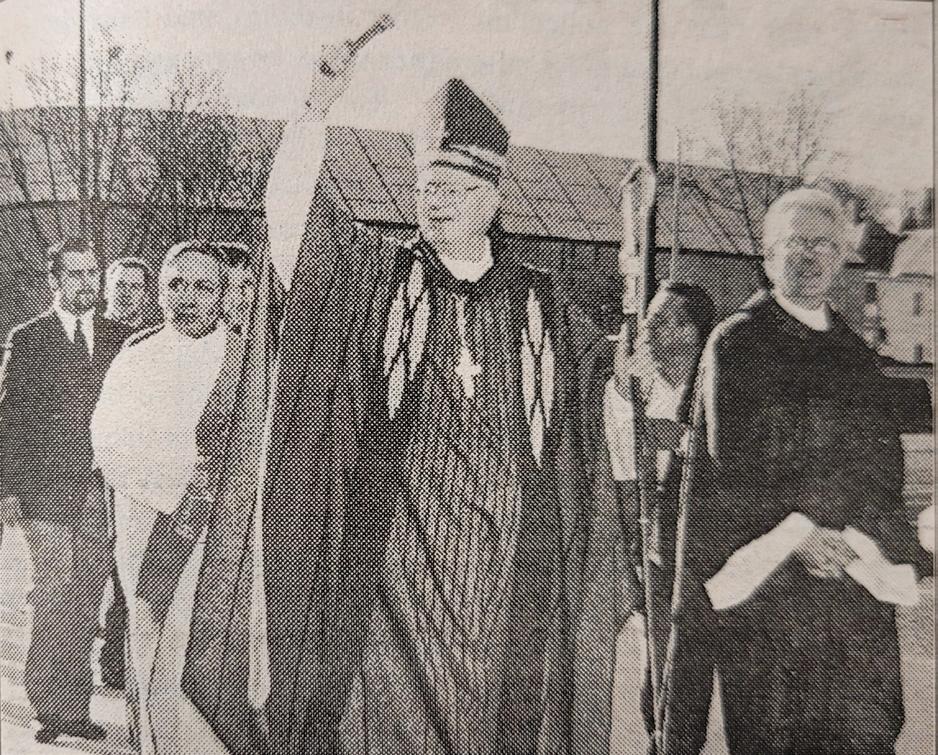
Bishop Harrington leads a procession around the new addition to a renovated St. John's School [part of renovations to St. John the Evangelist Church (now Co-Cathedral) and School in Rochester], blessing the facility while the Litany of Saints is sung. The school renovation has made possible an enrollment nearly double that of three years ago.
Reprinted from December 2000.
Doing as she asked, he found the flowers and brought them back to her. The Virgin Mary then placed the flowers inside his tilma, the traditional cloaklike garment he had been wearing. She told him not to unwrap the tilma containing the flowers until he had reached the bishop.
When he did, Bishop Zumárraga had his own encounter with Our Lady of Guadalupe – through the image of her that he found miraculously imprinted on the flower-filled tilma. The Mexico City basilica that now houses the tilma has become, by some estimates, the world's most-visited Catholic shrine.
The miracle that brought the Gospel to millions of Mexicans also served to deepen Juan Diego's own spiritual life. For many years after the experience, he lived a solitary life of prayer and work in a hermitage near the church where the image was first displayed. Pilgrims had already begun flocking to the site by the time he died on Dec. 9, 1548, the 17th anniversary of the first apparition.

St. Pope John Paul II beatified St. Juan Diego in 1990, and canonized him in 2002.
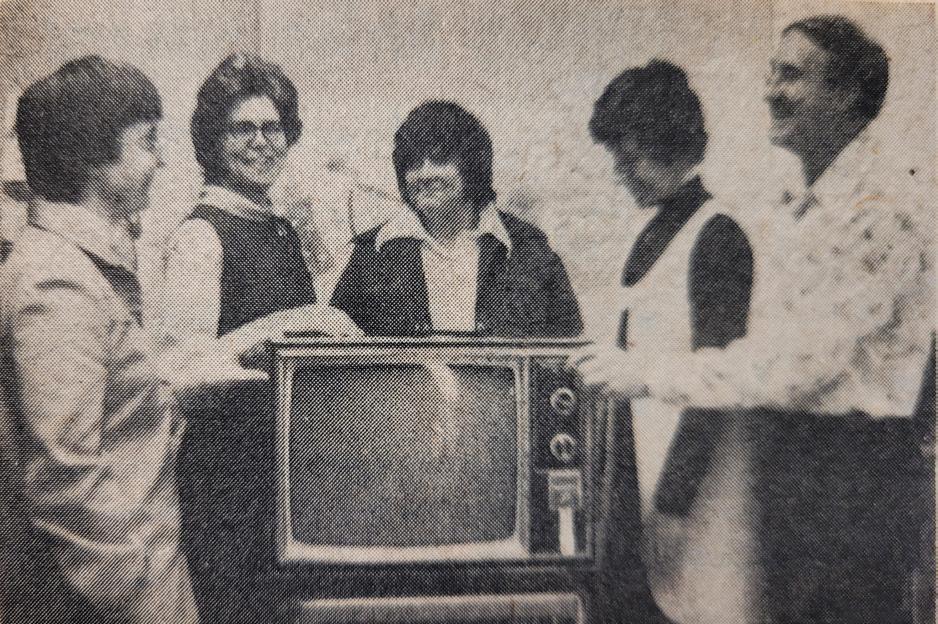
Religious education coordinators get input on video taping [lessons, at the Religious Education Center of Slayton]. ...The center, staffed by four Franciscan Sisters, represents a cooperative venture between eight area Catholic parishes (in Avoca, Currie, Dundee, Fulda, Iona, Lake Wilson, Slayton and Westbrook).
Reprinted from December 12, 1975.

Winona - Pictured above is His Excellency, the Most Reverend Edward A. Fitzgerald, D.D., LL.D., Bishop of Winona, turning the first spade full of ground at the site of the new Cathedral of the Sacred Heart. Ceremonies were held on Sunday, November 26. Reprinted from December 3, 1950.
From the Bishop
A Glimpse into the World of USCCB Committees
� have been a bishop for the last ten years, and during that time, I have served as chairman of two separate committees within the United States Conference of Catholic Bishops (USCCB). From 2017 to 2020, I was head of the committee on Evangelization and Catechesis, and from 2022 to 2025, I have led the committee on Laity, Marriage, Family Life and Youth (LMFLY). I suspect that for many the work of these sub-groups within the Conference remains something of a mystery. So, I would like to take the occasion of my departure from my second chairmanship to tell you a bit about what our committee has done.
I often referred to my staff at LMFLY (our playful acronym for the group) as the hardest working people in show business. For during my time as chairman, they took on an impressive number of projects. At my first meeting as chair, I commented that our committee had already done yeoman’s work in regard to the Church’s teaching on marriage and
*indicates event open to public
December 2, Tuesday
*8:30 a.m. - Staff Mass - The Chancery, Rochester
12 p.m. - Presbyteral CouncilThe Chancery, Rochester
December 3, Wednesday
11 a.m. - Minnesota Catholic Conference Board Meeting - St. Paul
December 4, Thursday Mass & Lunch with School Administrators - The Chancery, Rochester
December 5, Friday
*7 p.m. - Simbang Gabi Mass
Officials
The Most Rev. Robert Barron, Bishop of the Diocese of Winona-Rochester, announces the following:
Senior Status
Deacon John DeStazio: granted Senior Deacon status, effective December 1, 2025.
sexuality. Without denying for a moment the centrality of that contribution, I said, I wanted the committee to look at the question of mental illness in our society, especially among the young. My Word on Fire ministry had convinced me (and statistics backed me up) that armies of young people were suffering from suicidal ideation, depression, and anxiety. I wanted our group to look into this matter and advise the bishops on how to deal with it. Accordingly, we launched, with the cooperation of the committee on Domestic Justice and Human Development, a national mental health initiative, whose purpose was to erase the stigma around mental illness, to give sufferers access to resources, and to raise consciousness of the problem within the Catholic world. When I, along with Archbishop Borys Gudziak, announced the inauguration of the mental health initiative at the USCCB meeting, the bishops responded with over an hour of questions, comments, and encouragement. In the course of the last three years, our committee has sponsored a number of round table discussions with church leaders and mental health professionals and has given diocesan leadership some of the tools they need to better address this matter in their local churches.
A second preoccupation of LYMFLY these last three years has been the development of a document on persons with disabilities. It had been over 40
- Co-Cathedral of St. John the Evangelist, Rochester
December 6, Saturday
9:30 a.m. - Diocesan Pastoral Council - The Chancery, Rochester
*4:30 p.m. - Mass - Co-Cathedral of St. John the Evangelist, Rochester
December 7, Sunday
*6 p.m. - Parish Mission TalkCathedral of the Sacred Heart, Winona
December 8, Monday
2 p.m. - IHM Seminary Finance Council - Immaculate Heart of Mary Seminary, Winona
*5:30 p.m. - Holy Day Mass - Cathedral of the Sacred
Presbyteral Council
Rev. Jordan Danielson: elected as the Worthington Deanery Representative for the Presbyteral Council, to fill a vacancy through 2027, effective October 2, 2025.
years since the bishops of the United States last addressed this matter, and the conviction of our committee members was that a new statement was long overdue. Once again, when I presented the proposal to the entire body of bishops, there was an enthusiastic and encouraging response. Over the past several years, we have been doing wide consultation with the many individuals and groups that care for those with disabilities, both mental and physical. As you can probably imagine, people have very strong feelings on the topic! Accordingly, there have been spirited discussions, sometimes even sharp disagreements, as the document has gone through various stages of the editorial process. Our hope is that the statement, once finally formulated, will help bishops to minister more effectively to this most important constituency.
A third focus of my chairmanship has been the writing of a new document on the role and ministry of the laity in the Church. Once again, it has been many years since the Conference expressed itself formally in this regard (Co-Workers in the Vineyard of the Lord from 2005). At my prompting, the committee decided to dedicate the document, not so much to lay ministries within the Church, but rather to the role of the laity in the transformation of the world. One of the principal concerns of the fathers of Vatican II was to encourage the laity to bring the light of Christ to the
Heart, Winona
December 10, Wednesday Presidential Religious Liberty Commission - Dallas, TX
December 11, Thursday
12 p.m. - Deans Meeting - The Chancery, Rochester
2:30 p.m. - Clergy Personnel Committee - The Chancery, Rochester
*5 p.m. - Christmas TV MassThe Chancery, Rochester
December 12, Friday
2 p.m. - Our Lady of Guadalupe Mass - Federal Correctional Institution, Waseca
December 13, Saturday
*4:30 p.m. - Mass - Sacred
Rev. Thé Hoang: reelected to a three-year term as an At-Large Representative for the Presbyteral Council, effective October 2, 2025.
Pension Plan for Priests
Rev. Gregory Parrott: reelected to a three-year term as the age
realm that is proper to them, namely, the secular order. They wanted the laity to find their personal sanctification in the sanctification of the worlds of education, finance, entertainment, law, government, the family, medicine, etc. But I have long wondered whether the Church has adequately communicated this calling, this mission peculiar to the laity. Consequently, we have been holding listening sessions within dioceses, with groups of lay leaders, and with the bishops of the country in order to prepare this statement. In fact, “fraternal dialogues” among the bishops at our most recent USCCB meeting were dedicated to this topic. My hope is that the document will appear sometime in the coming year.
Another aspect of our committee’s work has been the periodic issuing of directives, statements, and formal teachings with respect to matters of pressing political importance.
LMFLY, obviously, is concerned with anything dealing with the family and sexuality. Hence, over my signature as chair, a number of such declarations have gone out, dealing with legislation regarding transgenderism, same-sex marriage, IVF, etc. But I have also articulated the Church’s concern about artificial intelligence, pornography, and certain insurance mandates repugnant to Catholic teaching. As is typically the case, these expressions of Catholic moral
Heart, Hayfield
December 15-16, MondayTuesday
Catholic University of America Board Meeting - Washington, D.C.
December 16, Tuesday
4:30 p.m. - Papal Foundation Dinner - Washington, D.C.
December 19, Friday
2 p.m. - Bishop's Cabinet - The Chancery, Rochester
December 20, Saturday
*5 p.m. Mass - Sacred Heart, Waseca
December 21, Sunday
*8:30 a.m. Mass - St. Rose of Lima, Lewiston
25-50 Representative on the Pension Plan for Priests Board of Trustees, effective July 1, 2025.
Catholic Schools
Mr. Jeff Brengman: appointed to a three-year term on the Rochester Catholic Schools
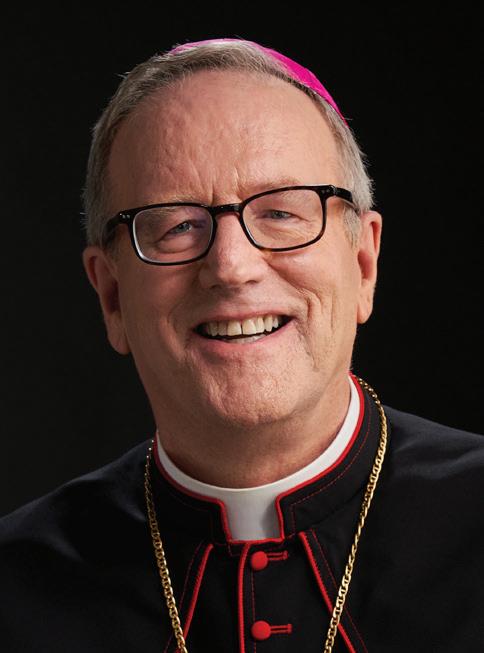
and political doctrine never neatly fall into the secular binary of “liberal” or “conservative,” which means that they inevitably awaken controversy. But so be it. I have enjoyed both of my committee chairmanships, but I’m also glad to cede my LMFLY role to Bishop Edward Burns of Dallas, a marvelous man and good bishop. I hope this brief expose has given you an idea of the work of the USCCB committees, which is accomplished, for the most part, under the radar. The purpose of all of the committees is simply to help individual bishops minister more effectively to their people by giving advice, providing resources, and focusing energies within the Church. Please pray for their success.
December 23, Tuesday
11:30 a.m. - Diocesan Staff Christmas Party - The Chancery, Rochester
5:30 p.m. - Seminarian Gathering - Resurrection, Rochester
December 24, Wednesday
*4 p.m. - Christmas Eve MassCathedral of the Sacred Heart, Winona
December 25, Thursday
*10:30 a.m. - Christmas Day Mass - Co-Cathedral of St. John the Evangelist, Rochester
December 28, Sunday *10 a.m. - Jubilee Year Closing Mass - Cathedral of the Sacred Heart, Winona
Board of Trustees, effective November 1, 2025.
Mr. Nick Jarrett: appointed to a three-year term on the Rochester Catholic Schools Board of Trustees, effective November 1, 2025.
Bishop's Calendar
Non Nisi Te Domine
Bishop Robert Barron
Una mirada al mundo de los comités de la USCCB
Por el OBISPO ROBERT
BARRON
�e sido obispo durante los últimos diez años y, durante ese tiempo, he sido presidente de dos comités distintos dentro de la Conferencia de Obispos Católicos de los Estados Unidos (USCCB). De 2017 a 2020, fui jefe del comité de Evangelización y Catequesis, y de 2022 a 2025, he dirigido el comité de Laicos, Matrimonio, Vida Familiar y Juventud (LMFLY). Sospecho que para muchos el trabajo de estos subgrupos dentro de la Conferencia sigue siendo un misterio. Por eso, me gustaría aprovechar la ocasión de mi despedida de mi segunda presidencia para contarles un poco lo que ha hecho nuestro comité. A menudo me refería a mi personal de LMFLY (nuestro divertido acrónimo para el grupo) como las personas más trabajadoras del mundo del espectáculo. Durante mi mandato como presidente, asumieron un número impresionante de proyectos. En mi primera reunión como presidente, comenté que nuestro comité ya había realizado una labor encomiable en lo que respecta a la enseñanza de la Iglesia sobre el matrimonio y la sexualidad. Sin negar en ningún momento la importancia de esa contribución, dije que quería que el comité examinara la cuestión de las enfermedades
mentales en nuestra sociedad, especialmente entre los jóvenes. Mi ministerio Word on Fire me había convencido (y las estadísticas me respaldaban) de que un gran número de jóvenes sufrían ideas suicidas, depresión y ansiedad. Quería que nuestro grupo estudiara este asunto y asesorara a los obispos sobre cómo abordarlo. En consecuencia, con la colaboración del comité de Justicia Doméstica y Desarrollo Humano, pusimos en marcha una iniciativa nacional de salud mental cuyo objetivo era eliminar el estigma que rodea a las enfermedades mentales, facilitar el acceso a los recursos a quienes las padecen y concientizar sobre el problema dentro del mundo católico. Cuando, junto con el arzobispo Borys Gudziak, anuncié la puesta en marcha de la iniciativa de salud mental en la reunión de la USCCB, los obispos respondieron con más de una hora de preguntas, comentarios y aliento. En el transcurso de los últimos tres años, nuestro comité ha patrocinado una serie de mesas redondas con líderes eclesiásticos y profesionales de la salud mental y ha proporcionado a los líderes diocesanos algunas de las herramientas que necesitan para abordar mejor este asunto en sus iglesias locales. Una segunda preocupación de LYMFLY en estos últimos tres años ha sido la elaboración de un documento sobre las per-
On N �vember 1 , the Solemnity of All Saints, Bishop Barron celebrated Mass with women attending the Beloved Diocesan Women's Conference at St. Ann Church in Janesville.
Attendees also heard presentations by keynote speaker Elizabeth Leon, and by Lisa Gray, who is the sister of Michelle Dupong, whose third anniversary of being declared a Servant of God was the same day as the conference!
Photos by Emily Smithley, media specialist for the Diocese of Winona-Rochester.
sonas con discapacidad. Habían pasado más de 40 años desde la última vez que los obispos de Estados Unidos abordaron este tema, y los miembros de nuestro comité estaban convencidos de que hacía tiempo que se necesitaba una nueva declaración. Una vez más, cuando presenté la propuesta a todo el cuerpo episcopal, la respuesta fue entusiasta y alentadora. Durante los últimos años, hemos llevado a cabo amplias consultas con muchas personas y grupos que se ocupan de las personas con discapacidades, tanto mentales como físicas. Como probablemente puedan imaginar, ¡la gente tiene opiniones muy firmes sobre el tema! En consecuencia, ha habido animados debates, a veces incluso desacuerdos agudos, a medida que el documento pasaba por las distintas etapas del proceso editorial. Esperamos que la declaración, una vez formulada definitivamente, ayude a los obispos a atender más eficazmente a este importantísimo sector de la población.
Un tercer aspecto central de mi presidencia ha sido la redacción de un nuevo documento sobre el papel y el ministerio de los laicos en la Iglesia. Una vez más, han pasado muchos años desde que la Conferencia se pronunció formalmente al respecto (Co-Workers in the Vineyard of the Lord, 2005). A instancias mías, el comité decidió dedicar el documento,
no tanto a los ministerios laicos dentro de la Iglesia, sino más bien al papel de los laicos en la transformación del mundo. Una de las principales preocupaciones de los padres del Concilio Vaticano II era animar a los laicos a llevar la luz de Cristo al ámbito que les es propio, es decir, el orden secular. Querían que los laicos encontraran su santificación personal en la santificación de los mundos de la educación, las finanzas, el entretenimiento, el derecho, el gobierno, la familia, la medicina, etc. Pero durante mucho tiempo me he preguntado si la Iglesia ha comunicado adecuadamente esta vocación, esta misión propia de los laicos. En consecuencia, hemos celebrado sesiones de escucha en las diócesis, con grupos de líderes laicos y con los obispos del país, con el fin de preparar esta declaración. De hecho, los «diálogos fraternos» entre los obispos en nuestra última reunión de la USCCB se dedicaron a este tema. Espero que el documento se publique en algún momento del próximo año.
Otro aspecto del trabajo de nuestro comité ha sido la publicación periódica de directivas, declaraciones y enseñanzas formales sobre asuntos de importancia política urgente. LMFLY, obviamente, se ocupa de todo lo relacionado con la familia y la sexualidad. Por lo tanto, bajo mi firma como presidente, se

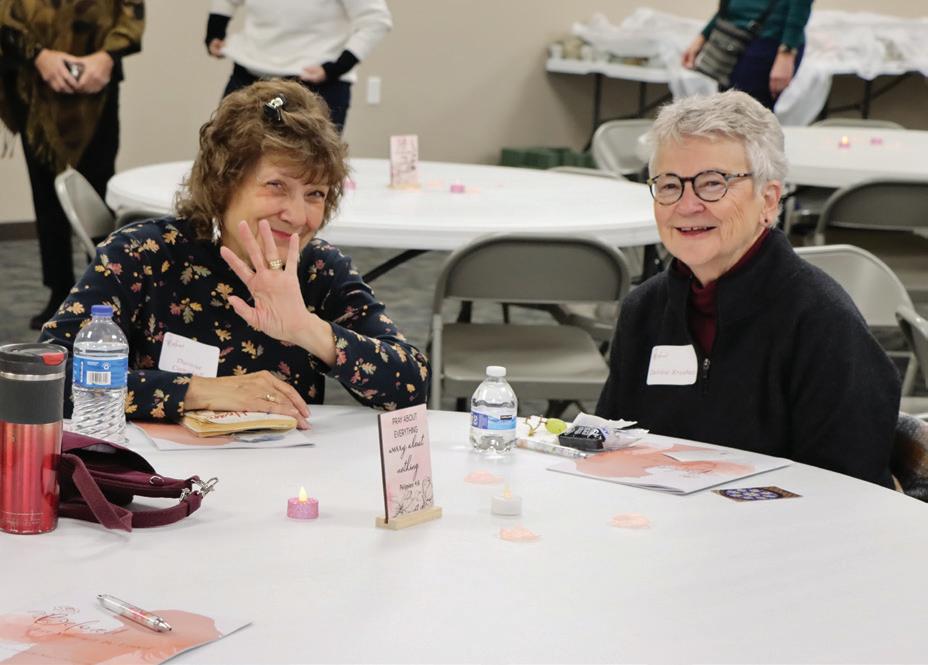
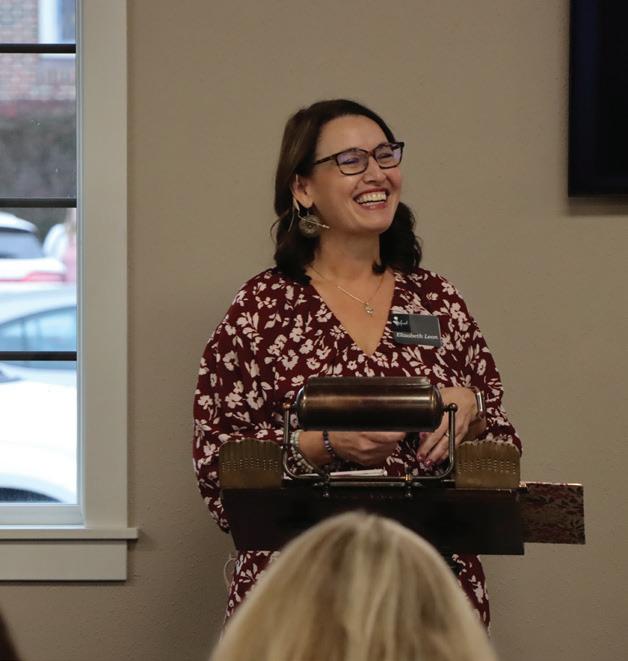
han publicado varias declaraciones de este tipo, que tratan sobre la legislación relativa al transgénero, el matrimonio entre personas del mismo sexo, la fecundación in vitro, etc. Pero también he expresado la preocupación de la Iglesia por la inteligencia artificial, la pornografía y ciertos mandatos de seguros repugnantes para la doctrina católica. Como suele ocurrir, estas expresiones de la doctrina moral y política católica nunca encajan perfectamente en la dicotomía secular de «liberal» o «conservador», lo que significa que inevitablemente despiertan controversia. Pero que así sea.
He disfrutado de mis dos presidencias de comité, pero también me alegro de ceder mi cargo en LMFLY al obispo Edward Burns de Dallas, un hombre maravilloso y un buen obispo. Espero que esta breve exposición les haya dado una idea del trabajo de los comités de la USCCB, que se lleva a cabo, en su mayor parte, de forma discreta. El propósito de todos los comités es simplemente ayudar a los obispos individuales a atender más eficazmente a su pueblo, ofreciéndoles asesoramiento, proporcionándoles recursos y concentrando energías dentro de la Iglesia. Por favor, recen por su éxito.

Opening the Door to Christ This Advent
By ISAAC LANDSTEINER
�
he season of Advent (which in Latin means “to come to”) is a time to prepare for and anticipate the joy of Christ’s coming. While much of the focus during this busy time of year is on preparing to celebrate the first coming of Christ at Christmas, Advent is also a time to focus on the second coming of Christ at the end of time, and the present coming of Christ into our hearts.
The scriptural accounts of the first and second coming of Christ offer us two rich, fruitful images which can help us to reflect more deeply on the meaning of Christ’s coming into our hearts. The first can be found in Luke 2:7: “she gave birth to her firstborn son. She wrapped him in swaddling clothes and laid him in a manger, because there was no room for them in the inn.” The second image is in Revelation 3:20: “Behold, I stand at the door and knock. If anyone hears my voice and opens the door, I will enter his house and dine with him, and he with me.”
In the midst of our busy preparations to host loved ones at Christmas parties and family gatherings, we see in these stories a familiar thread. Like our own activities this time of year, both of these are fundamentally stories of hospitality and homecoming. The challenge of Advent is not to allow the practical preparations of the season to overshadow our spiritual preparations to receive Jesus more fully into our hearts. Here are three suggestions on how to meet that challenge.
As you clean, declutter and decorate your home, make time to take an inventory of the condition of your heart. What thoughts, affections, worries, and actions clutter your heart and leave no room for Jesus to enter in? Once you have taken inventory, make time to avail yourself of the graces available through the sacrament of Reconciliation.
As you prepare family recipes and Christmas goodies, make time to sit with Jesus, truly present in the Eucharist, and ask him to give you a deeper taste of his love for you and a stronger desire to join him at the wedding feast of heaven.
As you shop for that perfect gift for your loved ones, make time to prepare a Christmas gift for Jesus, as well. Look for opportunities to give back in your community by helping, loving, and serving those
who are most in need. As Jesus himself said to us, “whatever you did for these least broth ers of mine, you did for me.”
As you consider these three ways of preparing for Christ’s coming, you may find that the present state of your heart looks more like a cold, damp stable than a warm, cozy inn. Perhaps the table you have set for the Lord is sparse and there are no gifts under the tree. But that is no reason for discourage ment. Our weaknesses and failures do not scare Jesus away. In spite of our lukewarm, distracted, or half-hearted efforts, still he stands at the door and knocks. Still, he desires to be with us.

In many ways, that is the central message of the story of Christmas. In Matthew 1:23, we read: “’Behold the virgin shall be with child and bear a son, and they shall name him Emmanuel,’ which means ‘God is with us.’” Our God is not distant, cold, or uncaring, watching from far off. He doesn’t wait for us to come to him, but rather, he seeks us out. He goes out in search of each of his lost sheep. He comes to meet each of us in our poverty.
And this should be a source of great hope for us! Unlike our physical preparations for Christmas, which rely on our own ability to prepare a home worthy of our guests, Jesus, himself our guest, is the one who accomplishes these things in our hearts, if we will only “hear his voice and open the door.”
Our brothers and sisters who are materially poor have much to teach us about the hopeful trust that is needed for this work.
In a recent message for the Ninth World Day of the Poor, Pope Leo wrote: “The poor can be witnesses to a strong and steadfast hope, precisely because they embody it in the midst of uncertainty, poverty, instability and marginalization. They cannot rely on the security of power and possessions. ... Their hope must necessarily be sought elsewhere.” Truthfully, even those who have great power and possessions find that they are often unreliable and ultimately fleeting. Pope Leo goes on to say, “Wealth often disappoints and can lead to tragic situations of poverty - above all the poverty born of the failure to recognize our need for God and of the attempt to live without him.”
Our motto at Catholic Charities is simple: “Providing Help, Creating Hope.” While we know that God is the only true source of hope, we strive to be his hands and feet in this world. By offering a pack of diapers, a warm bed, or simply a listening ear, we are there to remind the people we serve that in the midst of their anxieties and difficulties, God never abandons them. Jesus, Emmanuel, is the God who abides with them.
Every day, Jesus knocks on our door, desiring to enter more deeply into our hearts. He may come to us disguised as a humble piece of bread, a neighbor in need, or a family member home for the holidays. This Advent, listen for his voice, and open the door.
Isaac Landsteiner is the director of parish social ministry for Catholic Charities of Southern Minnesota.
National Religious Retirement Office Announces 2025 Collection
Submitted by ROBIN CABRAL
�he National Religious Retirement Office (NRRO) is announcing that the annual Retirement Fund for Religious collection will be held in parishes throughout the Diocese of Winona-Rochester on the weekend of Dec. 13-14.
In 2024, Catholics across the diocese contributed $72,698.86 to the collection, mostly through their home parishes. “The generosity of U.S. Catholics continues to make a profound difference in the lives of aging religious,” said John Knutsen, NRRO director. “This year, we invite all Catholics to help provide the care and dignity these women and men of faith so richly deserve.”
Rising healthcare costs and the absence of traditional retirement plans have placed significant financial strain on many religious communities. The Retirement Fund for Religious helps address this need, supporting more than 21,000 religious over the age of 70. In 2024, the average annual cost of care was about $56,600 per person, with skilled nursing care averaging $96,000.
Since its establishment in 1988, the collection has raised over $1 billion, with nearly $900 million distributed for direct care and over $103.7 million allocated to retirement planning projects.
In 2024, the appeal raised over $28.1 million, providing financial assistance for the retirement needs of 266 U.S. religious communities. Beyond financial aid, the collection supports educational programs, empowering religious communities to plan for their long-term needs.
About the NRRO
The NRRO coordinates the annual national appeal for the Retirement Fund for Religious and distributes financial assistance to eligible religious communities. It is sponsored by the Conference of Major Superiors of Men, the Council of Major Superiors of Women Religious, the Leadership Conference of Women Religious and the U.S. Conference of Catholic Bishops. For more information, visit retiredreligious. org, or contact Robin Cabral, by phone at (508) 6858899, or by email at campaign@retiredreligious.org.
Robin Cabral is the campaign director for the Retirement Fund for Religious collection.
Advent Resources for the Whole Family 7
By PETER MARTIN
�
ne of the wonderful things about living in a digital age is that there are many beautiful resources available for us to enrich our family life. One of the many downfalls, however, is that it can take forever finding wholesome content!
Here are just a few suggestions for you to assist your family in keeping Advent focused on preparing for Christmas!
Families with young kids could check out:
• catholicsprouts.com/advent-ideas/
• adventadventure.com
• catholicicing.com/10-meaningful-adventtraditions-for-catholic-families-with-littleto-no-prep-work/
Families with teenagers:
• messyfamilyproject.org/programs/ advent/
• wordonfire.org/ (Reading the daily Gospel reflections as a family)
• lifeteen.com/preparing-teens-advent/
Another website with good ideas:
• ewtn.co.uk/article-7-ways-to-liveadvent-as-a-catholic-family/

We look forward to offering a monthly article in The Courier to assist in enriching your family’s faith (stay tuned)!

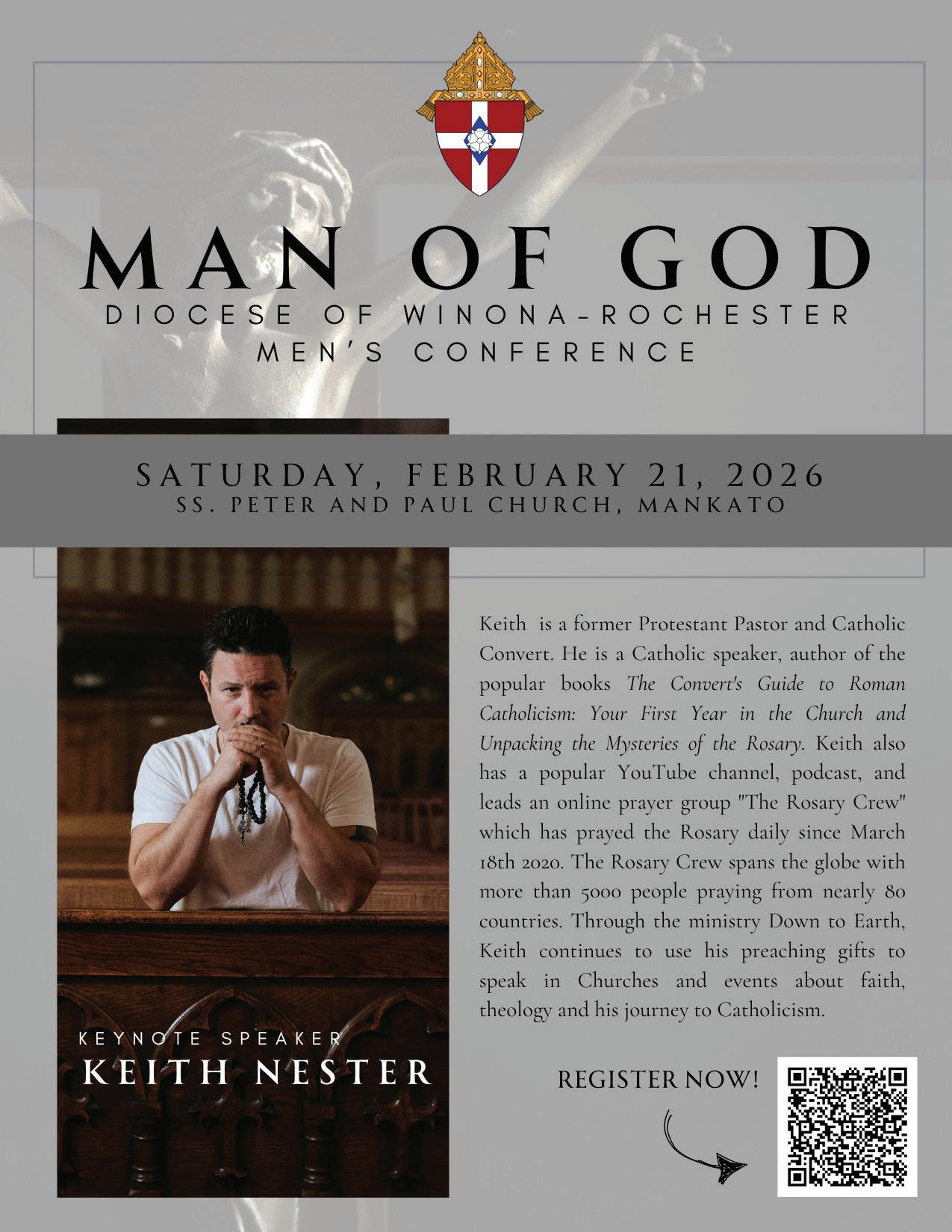
Peter Martin is the director of life, marriage & family for the Diocese of WinonaRochester.
Seminarians Foster Brotherhood Through Community Council
By NICOLE WENINGER
�
he Immaculate Heart of Mary seminarians are all actively involved in more than just traditional academics. Some cook, others sing, and some even cut the hair of their brother seminarians. One such extra-curricular is Community Council, a group of student leaders and formators who meet to discuss the well-being of the rest of the seminary. Sophomore seminarian Thomas Lambrecht from the Diocese of Winona-Rochester shares his experience:
The Immaculate Heart of Mary Seminary is more than just an educational school or a ‘training’ for the priesthood. It is a process of formation, assisted by the formators but ultimately originating from, and continuing through, the work of God himself, who truly transforms the interior man, configuring him to the model of Christ. One vital component of this formation is our communal life. By eating, praying, studying, and striving for holiness together, we become not just friends, but real brothers. To guide and develop that fraternity, we participate in a Community Council. This group of elected class prefects, along with the head prefect, formators, and the IHM representative

to the Student Senate, serve to advise the rector and support dialogue between the faculty and the seminarian body.
The Community Council meets once a month to discuss the vision of fraternity within the seminary community, as well as its implementation. The meeting begins in prayer, followed by a report from the Student Senate representative and a report from the faculty. The rector then addresses areas of focus and asks for input on his ideas. The prefects are able to address any questions or concerns brought to them from their respective classes, and they then report that information back to the seminarian body. Through this system, effective dialogue can be reached between the classes and
the formators. Recently, the Community Council discussed monthly Spanish Masses, helped to guide and support Fraternity Groups within the house, and planned an All Hallow's Eve party with trivia, desserts, and other activities. Whether it be assisting the rector, planning events, or encouraging the unity of the seminary community as a whole, the Community Council strives to uphold a key feature of our life here at the Immaculate Heart of Mary Seminary.
To follow more stories like Thomas’s, please visit our Facebook page at facebook.com/ihmseminary.
Nicole Weninger is a marketing and communications associate for Immaculate Heart of Mary Seminary.
Convent Expansion Breaks Ground
By NICOLE WENINGER
�he Wieser Brothers have arrived! As of Monday, October 27, the long-awaited expansion of the Immaculate Heart Convent is officially underway. With gratitude and anticipation, the Religious Sisters of Mercy of Alma, MI, watched as the first steps of construction took shape - removing the old driveway concrete to make room for a new addition that will soon become a space of hospitality and prayer.
The convent is currently home to four Religious Sisters of Mercy, several of whom teach at Saint Mary’s University.
Sister Mary Micaela teaches “The Bible: Encounter with God” to the Immaculate Heart of Mary Seminary’s first-year seminarians.
Sebastian Kolarsky, a seminarian from the Diocese of Madison, shares, “In [S]ister [Mary Micaela]'s class, I've grown in a greater understanding of the context of the biblical narrative, as well as how to properly read and interpret the Bible in line with Church teaching and tradition. Sister is a wonderful professor! Her witness of a lifelong commitment to Christ, the Church, and teaching have been very impactful on my own understanding of my vocation. Her example enlightens my hopes in service to Christ and the Church.”
Sister Agnes Mary directs the university’s nursing program, where she helps students unite professional excellence with a Catholic vision of care for the whole person. Her courses emphasize the dignity of the human person made in the image of God and the call to serve others with compassion. On September
30, the sisters hosted a picnic for the nursing department faculty and their families. Guests were invited to participate in Holy Hour in the convent chapel, followed by lawn games and a barbecue - a beautiful expression of hospitality and community.
Sister Mary Ignatius teaches in the theology and philosophy department and helps with admissions at Saint Mary’s.
Sister Mary Frances is pursuing an education degree at Saint Mary’s while also leading the Catechesis of the Good Shepherd, a faith formation program for school-aged children and their families, held at Saint Luke’s Hall at Cotter Catholic School.
In addition to teaching and studying, the sisters enrich the wider community by hosting monthly “Aquinas Evenings” for young adults, offering a day of reflection for mothers, and speaking throughout the diocese about religious vocations.
In 2023, a small renovation transformed part of the convent’s garage into an expanded chapel space, making it possible for more people to join the sisters in prayer. The sisters hope that the new expansion will allow them to open their doors to even more gatherings for prayer, study, and fellowship. They are also part of a growing religious order and require more space before additional sisters can be assigned to the convent in Winona.
To help fund the $730,000 project, the sisters have launched the Heart of Mary Convent Campaign. Every gift - no matter the amount - is received with deep gratitude and remembered daily in the sisters’ prayers. Donors who contribute $1,000 or more by April 30, 2026, will be honored on a plaque within

the convent as a lasting sign of gratitude to those who helped build this home of mercy. At the completion of the project, all are invited to attend an open house and blessing of the new space.
Please prayerfully consider supporting the sisters. To donate or request mailing materials, visit catholicfsmn.org/convent-expansion-project or call 507-858-1275.
Sr. Mary Micaela plays spike ball at a gathering outside the Immaculate Heart Convent in Winona.
Minnesota Catholic Conference Inside the Capitol
New Studies Reveal Why Minnesota Should Not Decriminalize Sports Gambling
By MINNESOTA CATHOLIC CONFERENCE
� recent Pew Research Center poll shows that 47% of men under 30 believe online sports betting has harmful effects on society, a sharp increase from 34% in 2022. This shift is telling. Young men are the primary drivers of online sports gambling and are seeing the consequences firsthand.
Over the past decade, we’ve learned that tech companies excel at capturing attention online, often through addictive algorithms that prioritize profit over well-being. Gambling platforms are no different. They thrive on targeting repeat betters, even when it puts the poor and vulnerable at significant risk. But the more you bet, the more you lose.
Online sports betting platforms are consumerfraud schemes and should not be allowed to operate in our state. We need to continue to stand against their legalization.
A Moral Concern for the Human Person
Pope Leo XIV recently addressed the dangers of online sports gambling in a statement at the National Conference on Addictions. He warned that “the growing use of the internet, computers, and smartphones is associated not only with clear benefits, but also an excessive use that often leads to addictions with negative consequences for health such as compulsive gambling and betting, pornography, and an almost constant presence on digital platforms.”
Pope Francis also condemned sports betting, saying, “It makes me sad to see soccer games and sports stars promoting gambling platforms. That's not gambling. It is an addiction. It's putting your hand in the pocket of the people, especially the workers and the poor.”
Impact on Individuals and Families
Imagine a Minnesota where everyone carries a casino in their pocket. The temptation for a quick financial fix grows when unemployment rises, inflation squeezes families, and young people search for financial stability. It is during these vulnerable moments when gambling industries prey on individuals who are not in a financial state to wager bets in seconds. They promise instant wins but deliver lasting harm.
To prove this, new research shows that gambling companies earn more than half their profits from just five percent of their most addicted users. The ripple effects are real: increased poverty, family fragmentation, addiction, substance abuse, and even domestic violence are all symptoms. These harms would spread through our communities and would further implicate pastoral action when our priests are already experiencing high levels of burnout.
An Unjust Wealth Transfer
Online sports gambling is not entertainment; it is an industry designed to extract wealth. One study revealed that fewer than five percent of online sports gamblers come out ahead. The math is simple: the more people gamble, the more companies profit. That is why platforms like FanDuel and Caesars lure users with offers like “$200 in bonus bets after your first $5 wager.” These incentives are not generosity;

Proponents tout tax revenue as a benefit, but the numbers tell another story. At a 22% tax rate, projected revenue is about $80 million while industry profits approach $500 million. That means their total revenue is in the billions. Most of that money leaves Minnesota for out-of-state corporations. This is a massive, unproductive wealth transfer.
What Can We Do?
In 2025, the Minnesota Catholic Conference and its legislative allies stopped bills H.F. 1842 and S.F. 757 from advancing. These bills would have legalized online sports betting in Minnesota. But we will likely see another push during the 2026 session. Contact your state legislators now and urge them to oppose any future attempts to legalize online sports gambling.
The Minnesota Catholic Conference has been the public policy voice of the Catholic Church in Minnesota since 1967. The voting members of the MCC's board of directors are Minnesota's Catholic bishops.

When Headlines Scare Us
AI, Dignity of Work, and Stewardship in Southern Minnesota
By ELIZABETH WILLIAMS
� saw the viral “scariest chart of all time” meme on social media recently. Did you? It's the chart that lines up the last few years of S&P 500’s surge against the collapse in U.S. job openings. I’ve included it to the right for your quick reference.
I felt what I imagine many of you felt: unsettled, curious, and a little wary of whatever the next headline might mean for our neighbors and parishioners. I take every viral graphic with a grain of salt and then go down my rabbit hole: reading the primary data, comparing reputable analyses, and asking what this all means for work, dignity, and stewardship in our communities.
If you want the short pastoral framing up front: worry is natural, but Scripture calls us elsewhere. “Therefore I tell you, do not worry about your life, what you will eat or drink, or about your body, what you will wear… So do not worry about tomorrow; tomorrow will take care of itself” (Matthew 6:25–34). Faith doesn’t replace prudent planning; it reorients how we plan.

Below I trace what I found in my rabbit hole, what I think it suggests about the future of work, and how we as Catholic stewards can respond in Southern Minnesota.
What the Viral Chart Really Signals (And What It Does Not)
The chart that’s been circulating shows a striking divergence: stock markets have rallied strongly while job openings have fallen sharply since 2022. The underlying data are real and worth attention: job openings peaked in early 2022 and have since declined by roughly a third, while equity indices tied to AI leaders climbed substantially over the same period. That gap can feel like a moral and economic fracture.
But there are multiple plausible explanations for divergence beyond a single cause. Monetary tightening, trade and immigration policies, governmental spending and hiring shifts, sectoral shifts in demand, and concentrated gains in a handful of tech firms have all been named by analysts as contributors to the split between corporate valuations and labor market breadth. The chart provokes us to think deeper; it is a reason to ask better questions, not a final verdict.
Amazon and Automation
Today and by 2033
to avoid hiring over half of a million workers with a goal to automate 75% of their operations by 2033. This estimation of impact is based on current technology capability. If technology advances, they could reduce the need for human employees further.
• Amazon publicly reported 14,000 corporate job reductions linked to AI adoption in October 2025, while outsiders believe it may be closer to 30,000 corporate positions cut.
• Amazon’s own public statements emphasize efficiency gains from generative AI and agents that will change how certain work is done; internal memos cited in reporting suggest both reductions in some categories of hiring and new roles that require different skills.
Dilexi Te calls the Church to advocate for structures and policies that protect workers' dignity even while we responsibly adopt useful technologies.
Corporate adoption of robotics and AI is one tangible part of the shifting work landscape. Recent reporting from major outlets has documented two realities at Amazon that matter for our community:
• Internal strategy documents from the robotics and automation team this fall indicate plans
Local Impact of Automation and What History Tells Us
Taken together, the Amazon examples show a likely pattern for large businesses rather than a universal rule: large firms with capital and scale can automate routine, repetitive tasks faster than smaller employers. Large firms will likely reduce hiring in many roles while expanding hiring in some more technical, supervisory, or maintenance roles. What’s concerning to me is:
1. These cuts & adds are coming at different job skill levels.
2. The percentage of job cuts vs. job additions is unclear.
3. The timing at which this could be a reality locally is unclear.
For Southern Minnesota, although it is difficult to estimate when, we’ll likely see an impact across warehouses, fulfillment centers (like the Amazon center in Stewartville), and among our many manufacturing companies.
But rather than overreact, we can look at economic history in an attempt to foresee the future. Transformative technologies (electrification, mecha-
nization, and the internet) altered the composition of jobs, often reducing some roles while creating others. Economists and strategists who study AI stress a familiar caveat: AI may automate tasks, but it also augments many jobs and creates roles we don’t yet fully imagine. As one recent synthesis put it, each wave of transformation brings both disruption and opportunity; the likely net effect for employment over time can be positive, but only if workers can access reskilling and transition support. What I believe is needed is continued dialogue with local businesses and local educational institutions to ensure our community is prepared for change, and the dignity of workers is upheld. By investing in skill formation, childcare, transportation, and other wraparound supports, the risks of displacement don’t disappear, but they can shrink, and the promise of new, dignified work grows.
Dignity of Work and the Moral Frame from Dilexi Te
Pope Leo’s Apostolic Exhortation Dilexi Te places the human person at the center of economic life; economic choices must respect the intrinsic worth of workers and avoid reducing people to mere instruments. That moral teaching shapes how Catholic organizations and employers should respond to technological change:
• Prioritize people over mere efficiency. Technology that raises productivity should not do so by treating workers as disposable.
• Invest in training and reskilling that preserve dignity and bring new opportunities, rather than leaving people behind.
• Design workplace transitions with accompaniment, fair severance, and clear pathways to new roles so families and communities aren’t left in the wake of “efficiency” gains.
Dilexi Te calls the Church to advocate for structures and policies that protect workers’ dignity even while we responsibly adopt useful technologies.
A Call to Action to Protect the Dignity of Work
This is the local call to stewardship. Southern Minnesota won’t be immune to national shifts, but we have strengths to leverage - resilient communities, committed parishes, community colleges, and employers who care about workers’ dignity. If your parish, employer group, or family is asking how to respond, we’d love to have a discussion with you. As we strive to be a beacon of Catholic stewardship in Southern Minnesota, the Catholic Foundation is in exploratory conversations about what the genuine needs are locally and how we can partner with you to prepare for a future that is coming fast.
Elizabeth Williams is the executive director of the Catholic Foundation of Southern Minnesota.
Image credit: derekthompson.org
Understanding Negative Subsidiary Fund Balances
By BREANNE SCHEID
�n ParishSOFT, many parishes track designated funds (like Building Fund, Youth Fund, Cemetery Fund, etc.) using subsidiary accounts under the main checking or savings account. These subsidiary accounts are not separate bank accounts - they are internal accounting buckets that tell us how much of the total cash is reserved for specific purposes.
What Does It Mean When One of These Subsidiary Funds Shows a Negative Balance?
It does NOT mean that the parish’s actual bank account is negative. The checking account can still have money in it.
A negative subsidiary balance means:
The parish has spent more of that specific designated fund than the amount that was currently sitting in checking allocated to it.
In other words:
• The funds belonging to that designation were held partly (or fully) in Savings, not Checking.
• When expenses were paid from checking, the system showed the subsidiary fund going into the negative because the money for that fund was still sitting in savings.
What Needs to Happen?
To correct the negative balance, the parish needs to transfer money from Savings to Checking for the amount that fund requires.
This does not create new money - it simply moves the cash to where it should be so the accounting matches the actual intended balance of that fund.
A Simple Example
Congratulations to the following parishes, which have met their goals for the 2025 CMA!
Every dollar given beyond the parish’s goal is returned to the parish to address local needs!
Adams
Sacred Heart
Blooming Prairie
St. Columbanus
Byron
Christ the King
Canton
Assumption
Chatfield
St. Mary
Currie
Immaculate Heart of Mary
Dodge Center
St. John Baptist de la Salle
Easton
Our Lady of Mount Carmel
Fulda
St. Gabriel
Good Thunder
St. Joseph
Grand Meadow
St. Finbarr
Hayfield
Sacred Heart
Heron Lake
Sacred Heart
Hokah
St. Peter
Jackson
Good Shepherd
Janesville
St. Ann
Johnsburg
St. John
Kasson
Holy Family
Kellogg
Immaculate Conception
La Crescent
Crucifixion
Lakefield
St. Joseph
LeRoy
St. Patrick
Litomysl
Holy Trinity
Lyle
Queen of Peace
Mabel
St. Olaf
Mankato
St. Joseph the Worker
St. Thomas More
Newman Center
Mazeppa
Ss. Peter & Paul
Medford
Christ the King
New Richland
All Saints
Owatonna
Sacred Heart
St. Joseph
Pipestone
St. Leo
Preston
St. Columban
Rochester
Co-Cath. of St. John the Evangelist
Pax Christi
St. Francis of Assisi
Rose Creek
St. Peter
My n�me �s BreAnne Sc�e�d, and I live on a farm outside of Easton with my husband Nate and our four children.
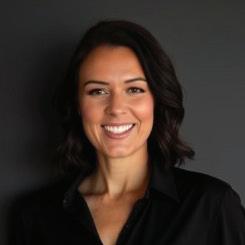
I’m the owner of Veritas Financial Solutions, a business dedicated to helping Catholic parishes, schools, and cemeteries strengthen their financial management and stewardship.
In addition to my work with Veritas, I also write articles on my LinkedIn page that highlight the bookkeeping and accounting topics I most often see within our parishes. My goal is to make these articles both educational and relatable - sometimes even adding a little humor to the day-to-day realities of parish financial life.
How to Say This Simply in a Meeting
The checking account isn’t negative. The negative balance is just telling us that some of the designated money for that fund is still in savings. We need to transfer that amount from savings to checking to match where the money was spent.
Why This Matters
This keeps:
• Designated funds honest and clear
• The audit trail correct
• The finance council able to see true available balances for each fund
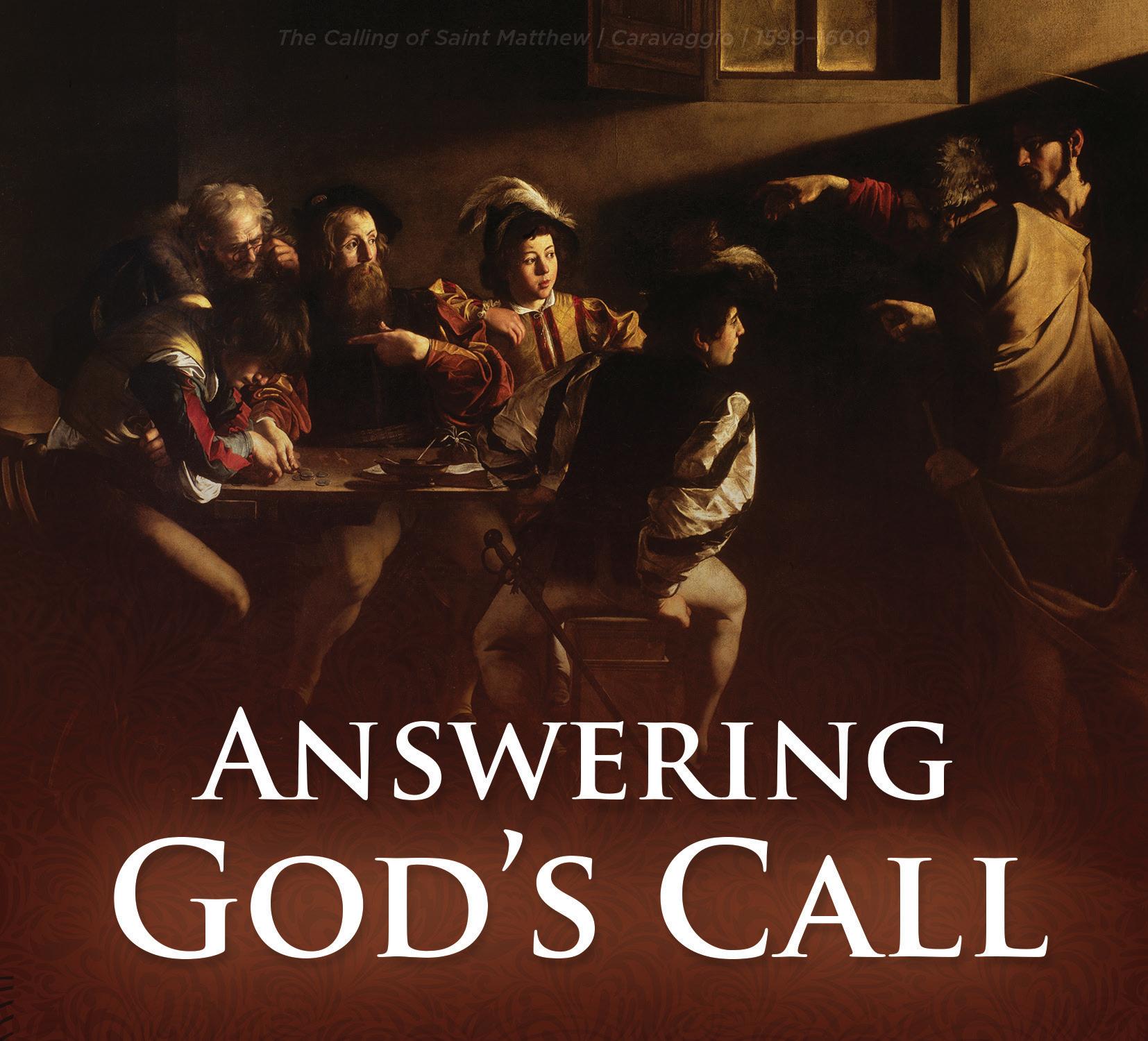
Sherburn
St. Luke
Simpson
St. Bridget
Slayton
St. Ann
Spring
Valley
St. Ignatius
St. Clair
Immaculate Conception
Stewartville
St. Bernard
Wells
St. Casimir
Westbrook
St. Anthony
Christ's Healing Power in Counseling
By SARA AURINGER
The Saints and Christ Endured Suffering, and We Will Too
�
urelius was born in the year 354 in Algeria. After his mother and son died, he struggled with intense anger and depression. Despite the suffering he faced, Aurelius chose to accept God’s will for him. He filled his life with prayer, sacrifice and work as a bishop and writer. With the help of Christ, Aurelius overcame life’s difficulties. This man is known to us today as Saint Augustine. While Saint Augustine suffered from very human difficulties like depression and anger, these did not stop him from using his suffering to bring himself closer to God and fill his life with Christ.
Over the centuries, many saints have struggled with challenges, including mental illness, during various parts of their lives. Even Jesus endured trials. He suffered agony, torture, and ultimately death. But Jesus modeled how to endure suffering, and he did this by keeping his eyes on the Father. The saints emulate this. They faced hurdles, but, ultimately, they kept their eyes on Christ and invited him to be the center of their healing process.
We, too, will struggle with challenges throughout our lives. Whether these difficulties are depression and anger like Saint Augustine faced, or worry, stress, addictive habits, or relationship conflicts, these struggles are normal and a part of being human.
Support During Life’s Valleys
What matters when faced with challenges is how we work through them. Sometimes we might try to work through difficulties without help from others. Other times, when we endure a really big challenge, such as a life-altering event, unexpected news, or persistent stress, we might get stuck and cannot move on without outside support.
In addition to Christ’s love, another beautiful gift God blessed us with are our brothers and sisters in Christ. We are not meant to journey toward heaven alone. Family, friends and strangers can uplift us and encourage us when we fall.
However, you might find yourself, even after receiving support from oth ers, continuing to struggle. You might have persistent troubles like wor ries, low mood, irritability, addic tion, or trauma. Your emotions and behaviors might negatively impact school/work, home life, and rela tionships. If your mental health is negatively affecting your life, then it is a good time to seek a lending hand. Two of the most commonly recommended treatments for mental illness are medication and mental health therapy.
The Wonderful Counselor
A beautiful thing about our human challenges is that we have a Divine Healer to redeem these struggles. Christ is known to us by many names, and one of them is Wonderful Counselor: “For to us a child is born, to us a son is given, and the government will be on his shoulders. And he will be called Wonderful Counselor, Mighty God, Everlasting Father, Prince of Peace” (Isiah 9:6). During Jesus’s life he counseled and guided those around him with empathy, kindness, firmness and encouragement. A good example of this is when Jesus met the Samaritan woman at the well (see John 4). Jesus counseled her with respect, patience, education, reassurance and instruction. The Samaritan woman chose to accept his counsel and spread his love to others.
Our Mother Mary is also known for her Good Counsel. She is ready to welcome us with a warm loving embrace when we seek her guidance. There are many ways to pray to our Mother, but there are a few specific prayers that call on Our Lady of Good Counsel:
“O Mary of Good Counsel, inflame the hearts of all who are devoted to you, so that all of them have shelter in you, O great Mother of God. O most worthy Lady, let everyone choose you as teacher and wise counselor of their souls, since you are, as Saint Augustine says, the counsel of the Apostles and counsel of all peoples. Amen.”
If you have something to share with Mary, she is eager to listen, hold, and respond to your needs.
The Importance of Christian Counseling
As mental health professional, I’ve talked about Christ and religion in sessions with patients, but he was not the center of the therapeutic change. Part of this was due to the environment in which I worked, and part of this was due to not asking patients if their faith was something they valued and wanted to include in therapy. I also fell into this boat when I was a patient. I sought my own therapy both with companies that did not practice Christian ther-
into Christ in every aspect of our lives, including therapy.
If you want to walk through this current chapter of life with someone who values your faith, wherever you are on that journey, please prayerfully consider Catholic therapy. When you see a Catholic mental health professional, Christ is often the center of therapy. With the patient’s permission, mental health professionals will intentionally invite Christ into the session. He is already there anyway, but his Spirit can work more directly with our open invitation.
During Catholic therapy, Christ works directly through the therapist and patient, and his Spirit moves where the patient needs it the most. Over time, barriers to God’s love are minimized and patients are more easily able to receive God’s healing in their lives. Some additional ways Christ might be incorporated into the session include prayer, visualization, Scripture, exploration of religious practices, and incorporating Christ into a variety of evidence-based interventions.
Christ Calls Us Out of and Redeems Suffering
Christ is essential to include in all aspects of our lives. One of my more recent trials taught me this. This particular trial was one of the toughest I have faced. But once I invited Christ into my life more fully because of this trial, he redeemed the suffering. Each day I continue to pursue a deeper relationship with Christ, and his love continues to overflow.
As in Saint Augustine’s story and the stories of many saints, the trials we face not only can bring us closer to Christ but also can ignite our hearts to share him with others. In pursuing Christ in everything we do, his love then overflows into all aspects of our lives. When we allow Christ to redeem our suffering (like mental illness) and be the center of our lives, we can embrace the calling he has for us and share his love with others the way he created us to.

Christ’s Calling for You
Mental health therapy is an investment of time, energy and money. However, the potential benefits (improved relationships, healthy thinking patterns, coping skills, self-care, etc.) far outweigh the cost. If you feel Christ is calling you to pursue therapy as a part of your healing journey and want to learn more, you can search online to find a therapist who might be a good fit. You can search by location, specialty, and insurance/payment type. You can also add to your search "Christian" or "Catholic therapists" if that is something you want to be intentional about including in sessions. Priests in the Diocese of Winona-Rochester also have a list of several of the Catholic providers in our area.
Mental health therapy can be a big step, but you are worth it. Christ equipped many brothers and sisters to help you on your journey, and he too is with you every step of the way.
Christ is knocking at the doors of our hearts waiting to be welcomed into all aspects of our lives. What is your response to his call?
Sara Auringer is a Licensed Professional Clinical Counselor in the Rochester area.
The Litany of Trust
By SHELLY HOLT
my beloved earthly father passed away on October 25 and was buried on November 1 - very fitting for a saint-on-earth type of a man. A good friend sent this litany to me, so I share it with all of you. Holidays can be difficult while in deep grief. I choose joy even in sorrow. I start and end my day with gratitude. Many days I talk to God with tears streaming down my cheeks. I take note of the small miracles. Thank you, Lord, for eyes, ears, nose, hands, feet, and heart. We
From disbelief in your love and presence - Deliver me, Jesus.
From the fear of being asked to give more than I have - Deliver me, Jesus.
From the belief that my life has no meaning or worth - Deliver me, Jesus.
From the fear of what love demands - Deliver me, Jesus.
From discouragement - Deliver me, Jesus.
That you are continually holding me, sustaining me, loving me - Jesus, I trust in you.
That you will teach me to trust youJesus, I trust in you.
That you are my Lord and my God - Jesus, I trust in you.
That I am your beloved one - Jesus, I trust in you.
That you will hear my prayers (mention your intentions here) - Jesus I trust in you.
In the name of the Father, and of the Son, and of the Holy Spirit.
Amen.
May you enter Advent and journey to the Christmas Season with complete trust.
Our next CCW member meeting will be on Saturday, January 10 in the Blue Earth/Mankato Area. In-depth speakers will be from Legislation (including Prolife and AntiPornography) and Commissions. Questions? Contact

The Uncertainties of Life
By DEACON ROBERT YERHOT, MSW
�bout 15 years ago, a young woman ran into her local church to tell the priest who had witnessed her marriage that she was going to have a baby. She asked the priest to bless her and her unborn child. He did. Moments later, a gunman stormed into the Cathedral of Our Lady of Salvation in Iraq and murdered the priest, the woman and her unborn child, and more than 50 Iraqis, simply because they were Catholics.
Life can be fragile. The unfolding of life is uncertain. Jesus says in the Gospels that his followers will be persecuted for believing in him, and some will be put to death. He tells us to persevere. He tells us that all sorts of things are going to happen to us, but none of them, as difficult as they may be, are to worry us, for he will provide whatever we need and he will never abandon us.
Yes, the unfolding of life is uncertain. Life can overwhelm us with fear and anxiety. Strangely, the certainty of death can bring us peace.
Jesus does not tell us how our lives will play out, nor does he tell us what hour we will die. It is not for us to know or to decide. God will reveal it at a time
he has known for all eternity.
The uncertainties, the tragedies, and the persecutions we may experience are not to be feared, for they are graced opportunities to give witness to our love for God and his love for us. We must not live in fear. We must embrace life each day, with all its uncertainties, trusting his love for us. We must adhere to Jesus Christ, be baptized into his death and resurrection, and remain in a graced relationship with him unto death.
We all will die a physical death. This is our common experience.
We all will experience a particular judgment at the moment of our death when it will be abundantly obvious what is our ultimate destination based on how we have chosen to live our lives. We all will experience a general judgment at the end of time when Jesus returns, and our bodies will be reunited with our souls.
The certainty of death does not much concern me because I believe in the presence of God, and in the resurrection to new life. I believe in life after death. I believe that Jesus Christ has conquered
Shelly Holt is the president of Rochester Diocesan Council of Catholic Women. She can be reached
death, that he has made death a portal through which we must pass into eternal happiness. I believe it because Jesus taught it, and I find Jesus to be credible and convincing. Where are we headed? What will be our ultimate destination? Are we moving in the right direction? Will we be with God for all eternity in heaven, or will we be separated from him in hell? The choice is ours.
May God bless all of you!
Deacon Robert Yerhot is the director of the diaconate for the Diocese of Winona-Rochester.
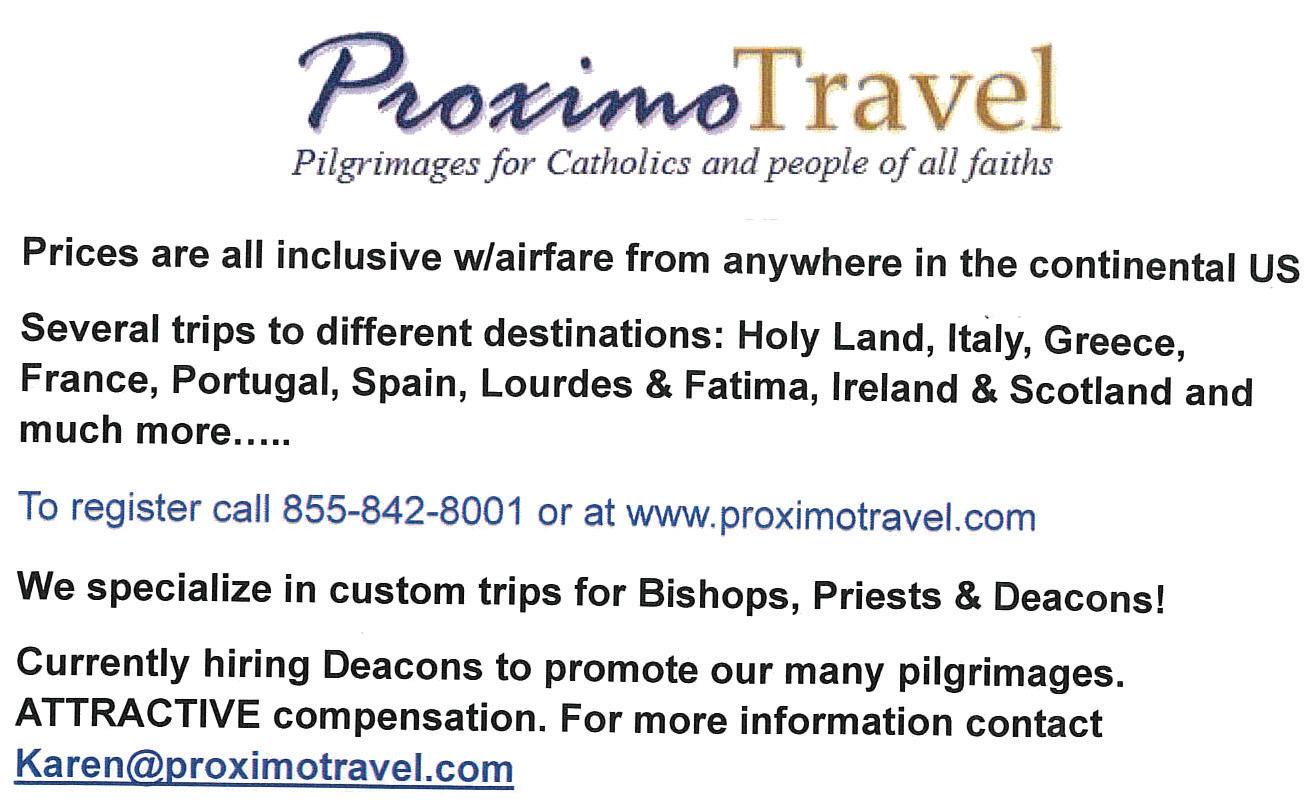
Institute of Lay Formation Welcomes 2025-2028 Cohort
�lease pray for the following members of the 2025-2028 ILF cohort! May our Lord encounter them in his love and transform them into his lay missionary disciples, who are ready to evangelize and disciple others in the Christian life.
Hannah Miers, of Saint John's School of Theology and Seminary, writes:
As I begin my journey with the Institute of Lay Formation (ILF) through the Diocese of Winona-Rochester, I hope to deepen my understanding of the Catholic faith and grow in my ability to share the Gospel with others. I look forward to developing both the knowledge and the confidence needed to evangelize in my parish and community, while also cultivating a closer relationship with Christ. Through ILF, I hope to encounter new perspectives, engage in meaningful discussions, and discern more clearly the ways God is calling me to serve. For a lay person discerning whether to join ILF, I would encourage them to approach it with openness and curiosity, trusting that God can work in unexpected ways through this formation. My advice would be to embrace both the challenges and joys of the program, knowing that it is an opportunity to grow in faith, leadership, and service. Ultimately, ILF is a chance to be equipped to live out your baptismal call more intentionally and confidently!
Kerry Haugh, of Saint Casimir Parish in Wells, writes:
So far, what I have enjoyed most about my fellow ILF participants is their deep love for Jesus and our Catholic faith. I am also grateful to be paired up with an "ILF companion," an ILF participant who holds me accountable in including prayer into my daily routine. As the expression goes, "iron sharpens iron."
Moreover, devoting time to praying different prayer forms and reading Scripture daily has been worthwhile. During our opening weekend ILF retreat, I learned that St. Mother Teresa of Calcutta once said, "If you are too busy to pray, you are too busy." This quote has hit home with me; it has played a role in changing my daily priorities. As I continue my lay formation, I am looking forward to my personal growth in my spiritual journey.
Some advice I would offer to anyone considering joining ILF would be that it is a great opportunity to deepen your relationship with Jesus and His Church. Joining ILF is a long-term commitment, but when it comes to your schedule, plan ahead. People plan ahead for vacations, work, and sporting events. My challenge to all lay Catholic adults is to sacrifice the things of this world that are currently consuming your time in order to be who you were created to be.
Supporting Hispanic Ministry Across the Diocese of Winona-Rochester
By NICOLE WENINGER
�cross the Diocese of Winona-Rochester, Hispanic Ministry is growing and thriving, thanks to the dedicated support of our priests, parishioners, and diocesan initiatives.
Fr. Raúl Silva, pastor of St. Mary’s Church and School, Worthington, and diocesan Vicar for Hispanic Ministry shares:
“There are 10 parishes in our diocese currently serving around 6,000 Hispanic parishioners every Sunday. We are blessed to have three Hispanic priests and one Hispanic deacon focused on Hispanic Ministry, along with about seven nonHispanic priests who also celebrate the sacraments in Spanish.”
Fr. Silva notes that funds from the Catholic Ministries Appeal (CMA) have played a vital role in strengthening Hispanic Ministry across the diocese. These funds help support leadership development



















and expand ministry efforts in our parishes.
Past CMA support has made significant events possible like the diocesan Year of Mercy celebration - attended by nearly 2,000 people - and the Eucharistic Congress. It has also funded retreats for Hispanic leaders, youth faith formation, and initiatives for the growing number of Hispanic students in our Catholic schools.
Your generosity makes this work possible. Please consider making a gift to the Catholic Ministries Appeal today to continue supporting Hispanic Ministry and other vital programs in our diocese.
Nicole Weninger is a marketing and communications associate for the Catholic Foundation of Southern Minnesota.
Nativity Sets, cont'd from pg. 1
including the sets that are too big to fit in containers). Each set is accompanied by documentation from the Holders, including its description, country of origin and original cost, and an explanation of how the Holders came to own it. Neil Drees says the information will be displayed alongside the nativity sets to enrich the experience of visitors to the museum.
"I think nativity sets bring different feelings from each individual person," Drees said. "To me, I enjoy the bigger sets that came from churches. I also like the sets that are made out of unique materials, such as brass, wheat, corn husks, etc."
Fr. Starasinich has seen quite a few of the sets as they are being prepared for display, but he'll wait

Assembly,
until he's seen them all before deciding on a favorite. At any rate, he appreciates the message this enormous collection will send.
"I like the Knights of Columbus motto 'Keep Christ in Christmas,'" he said. "I think that speaks well to this nativity collection and the various artistic displays of the story of the birth of our Savior, Jesus Christ. Just like the old television program A Charlie Brown Christmas and the song by Greg Lake, of Emerson, Lake and Palmer, I Believe in Father Christmas both emphasized a return to the real meaning of Christmas, I think that is also the main emphasis of the Nativity House museum."
Come and See
Neil Drees and Knights of Columbus Council 1201 invite any reader of The Courier to bring friends and family along for a visit to the Nativity House in its new location at Queen of Angels Church - 1001 Oakland Avenue East in Austin (door #1 along 1st Ave NE). The Christmas viewing schedule is November 30January 11, noon to 5 p.m. on Saturdays, and 10 to 5 p.m. on Sundays. To view the collection by appointment, whether in or out of season, call the parish office at 507-433-1888.
Donations from individuals and businesses have helped offset some of the expenses associated with the opening and operation of the Nativity House museum, but further help or donations would be
cont'd from pg. 1
President; updates (e.g., the new Liturgy of the Hours is expected to go into effect Ash Wednesday 2027); action items, including voting on USCCB officers and committee chairmen; and presentations –this year from an expert on AI, articulating how that technology is impacting various Catholic ministries.
The bishops also meet in Executive Session to discuss more sensitive matters, as well as regional meetings that can focus on more local concerns.

During the week of the Assembly, there are also numerous committee meetings, with topics ranging from Religious Liberty to Priorities and Plans to Laity, Marriage, Family Life and Youth (of which Bishop Barron was chair for the last three years).
I would be remiss if I did not mention the particular excitement of this year’s election of USCCB President and Vice President. Both three-year positions were voted upon this year, with the bishops choosing from 10 nominated candidates. Top on the list (which was alphabetical) was our own Bishop Barron, who made a third-place finish in the Presidential election. Although he was not elected as an USCCB officer, it was clear that Bishop Barron is well-respected by his brother bishops as a steady and trust-worthy leader.

greatly appreciated.
Drees said, "If you want to view this collection as art, they are beautiful. If you want to view this collection as historical, there are some very old sets. But if you want to see a collection of nativities depicting the birth of our Lord Jesus Christ, this is a must see!"
Nick Reller is the associate editor of The Courier
For me personally, the atmosphere that pervaded the week in Baltimore was that of a giant Catholic get-together. Due to connections derived from working in the Bishop’s office, being active in the consecrated life world, and having Catholic friends and acquaintances - priests, consecrated virgins, and laity - around the country, I found that I not only knew many of the bishops, USCCB staff, and other observers, but I continually discovered other mutual friends, surprising connections, or shared interests.
If one moment could sum up the November USCCB Assembly, I think it would be the opening Mass at the Baltimore Basilica. Witnessing a sea of bishops in our nation’s first cathedral, celebrating the feast of St. Leo the Great, pope, was a poignant reminder that the apostolic church endures to this day, and it was on full display in front of my eyes.
Leandra Hubka is the executive assistant to Bishop Robert Barron.
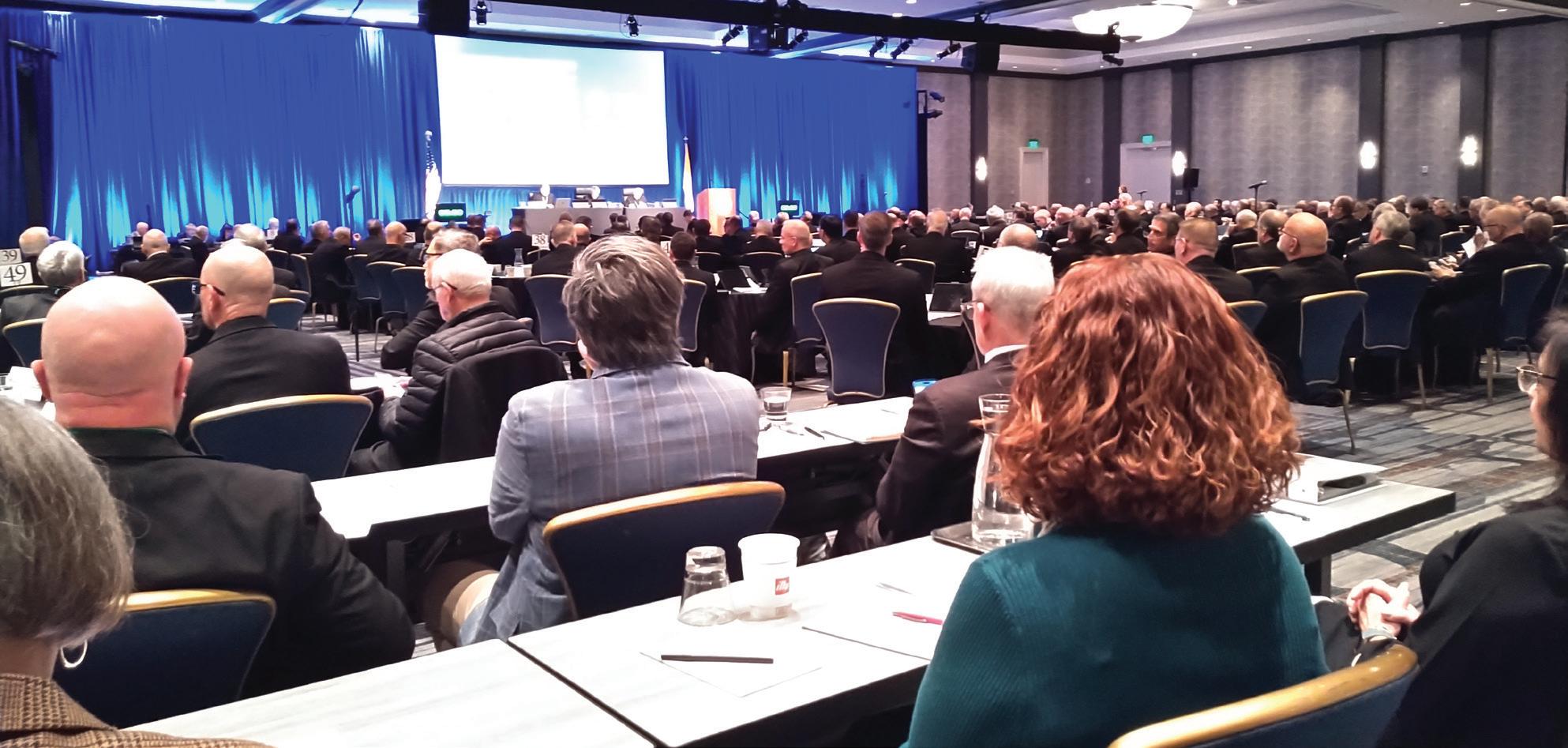
A view of the General Session, from the observers' corner.
My favorite place to hang out with Jesus, and my badge which got me past security.
A gr�u� �f 14 S�. M�ry's, W�n�n�, ��r�s���ners made a Jubilee Pilgrimage of Hope to Italy October 13-23. Their tour guide photographed them visiting St. Peter's Square for Pope Leo's October 15 General Audience. JULIE FITZGERALD took the lower left photo, and SANDY SCHILTZ took the close-up.
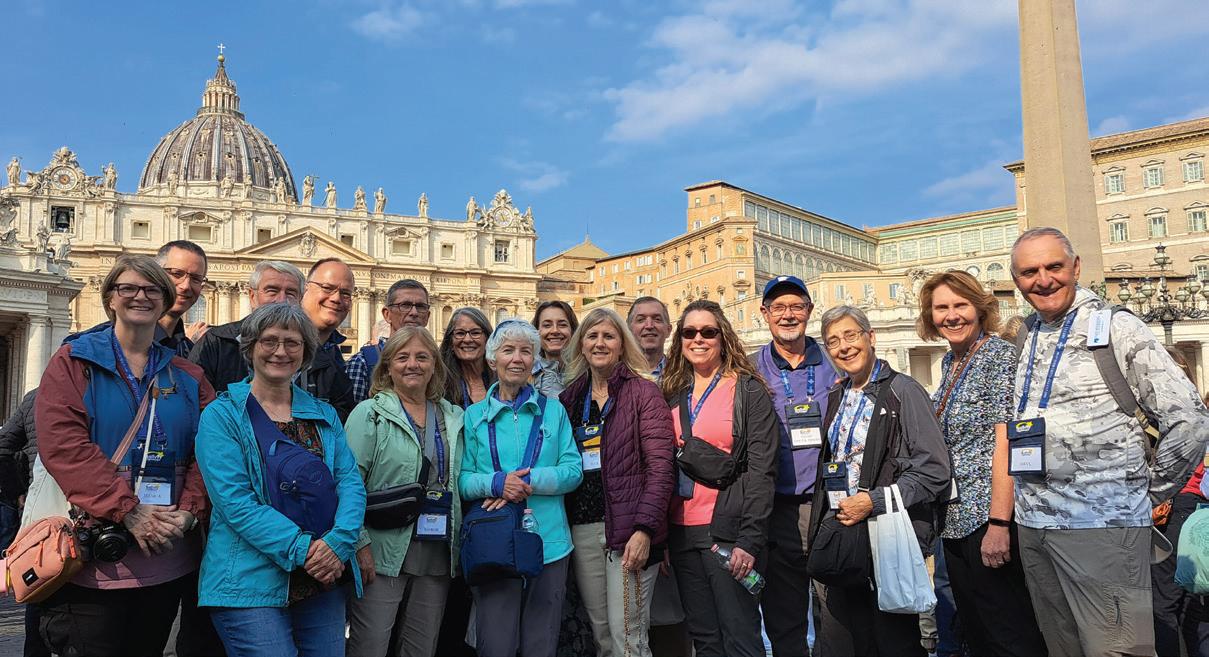
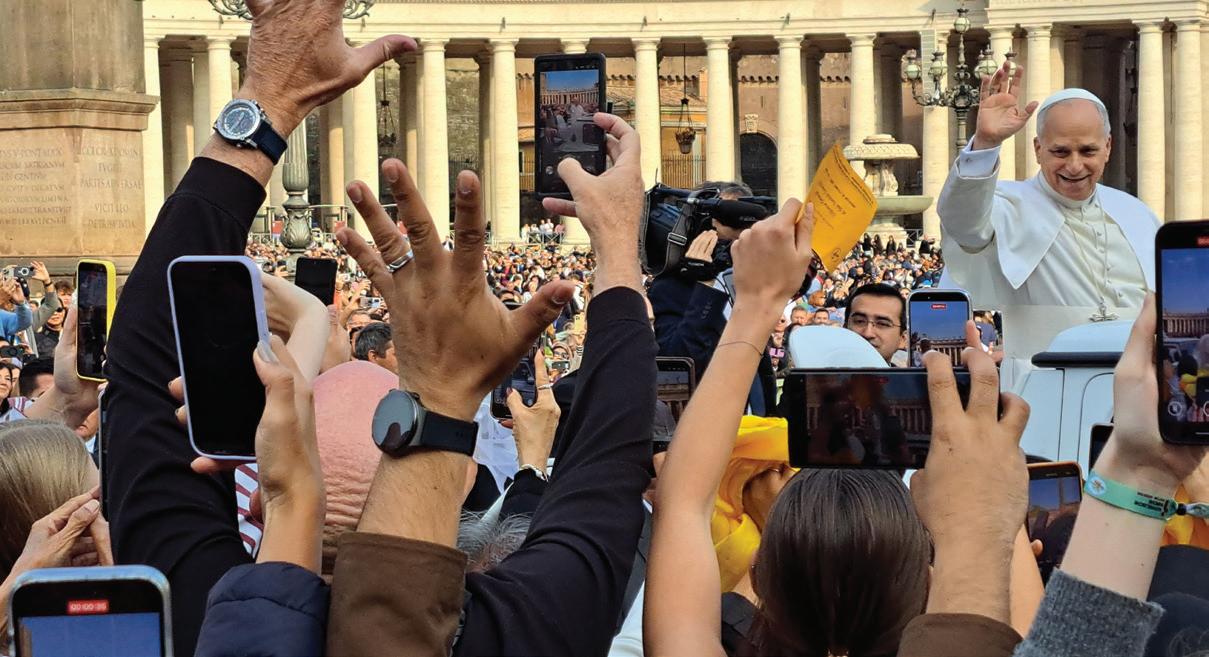
Remember the Advent Novena!
S��r��ng �n ��e Fe�s� �f S�. Andre�, November 30 (this year also the first day of Advent), the following prayer is traditionally recited 15 times a day until Christmas. This meditative prayer helps us increase our awareness of the real meaning of Christmas and prepare ourselves spiritually for the coming of Jesus.
Hail and blessed be the hour and moment in which the Son of God was born of the most pure Virgin Mary, at midnight, in Bethlehem, in the piercing cold.
In that hour vouchsafe, O my God, to hear my prayer and grant my desires, [mention your request here] through the merits of our savior Jesus Christ, and of his blessed mother. Amen.



S�uden� C�unc�l members from Sacred Heart School in Adams proudly display the 53 Boxes of Joy collected and packaged by our Sacred Heart School family! Thanks to the generosity of 92 students across Kindergarten through Grade 8, and our 50 Sacred Heart School families, these boxes are now on their way to children in need around the world through Cross Catholic Outreach's Box of Joy campaign.
Filled with toys, games, puzzles, candy, apparel, rosaries and essentials, these boxes reflect how Jesus is the glue that holds us together - uniting our school community in service and love. As we approach the Christmas season, we are reminded that Jesus is the Light of the World, shining brightly through every act of kindness and generosity.
At Sacred Heart School, service to others is at the heart of our mission, and these efforts are a beautiful example of our students living their faith in action. Thank you to all families who made this possible!
Photo and caption submitted by KATIE SCHAEFER, principal of Sacred Heart School in Adams.

The Televised Mass Is Offered Every Sunday
Sioux Falls - ODLT Channel 7 at 7 a.m.
Mankato - KEYC Channel 12 at 7:30 a.m.
Digital Channel 12.2 or Charter Channel 19 NEYC at 9:30 a.m.
Digital Channel 7 (DirecTV) or Channel 11 (DISH) KMNF at 9 a.m.
Rochester/Austin/Mason City
KIMT Channel 3 at 7:30 a.m.
MyTV 3.2 at 9 a.m.
Twin Cities - WFTC Digital Channel 29 or Channel 9.2 at 11:30 a.m.
Southeastern MN - HBC Channel 20 at 3 p.m. (repeated Wed. at 3:30 p.m.)
Winona/La Crosse/Eau Claire - WLAX/WEUX Channel 25/48 at 7:30 a.m.
and on our website, dowr.org (click "Weekly Mass")
